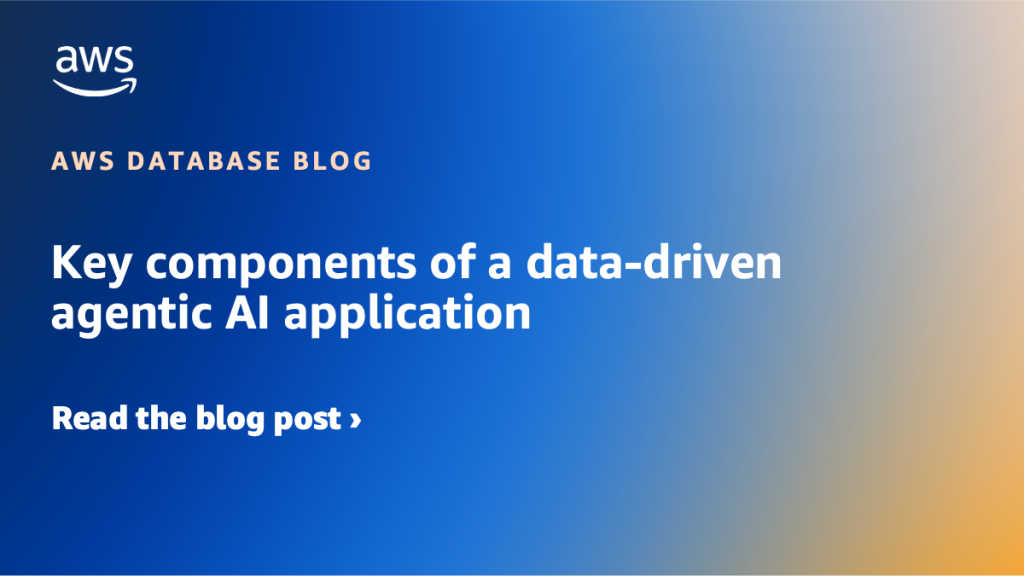AWS Database Blog
Category: Thought Leadership
Key components of a data-driven agentic AI application
In this post, we look at the costs, benefits, and drawbacks of replacing services for agentic AI with direct database access. Including those that work well and are proven in production, and new services yet to be built. Let’s take a closer look at the anatomy of an agentic AI application and what would factor into such decisions.
Achieve up to 1.7 times higher write throughput and 1.38 times better price performance with Amazon Aurora PostgreSQL on AWS Graviton4-based R8g instances
In this post, we demonstrate how upgrading to Graviton4-based R8g instances with Aurora PostgreSQL-Compatible 17.4 on Aurora I/O-Optimized cluster configuration can deliver significant price-performance gains – delivering up to 1.7 times higher write throughput, 1.38 times better price-performance and reducing commit latency by up to 46% on r8g.16xlarge instances and 38% on r8g.2xlarge instances as compared to Graviton2-based R6g instances.
Understanding transaction visibility in PostgreSQL clusters with read replicas
On April 29, 2025, Jepsen published a report about transaction visibility behavior in Amazon RDS for PostgreSQL Multi-AZ clusters. We appreciate Jepsen’s thorough analysis and would like to provide additional context about this behavior, which exists both in Amazon RDS and community PostgreSQL. In this post, we dive into the specifics of the issue to provide further clarity, discuss what classes of architectures it might affect, share workarounds, and highlight our ongoing commitment to improving community PostgreSQL in all areas, including correctness.
How Amazon Finance Automation built an operational data store with AWS purpose built databases to power critical finance applications
In this post, we discuss how the Amazon Finance Automation team used AWS purpose built databases, such as Amazon DynamoDB, Amazon OpenSearch Service, and Amazon Neptune together coupled with serverless compute like AWS Lambda to build an Operational Data Store (ODS) to store financial transactional data and support FinOps applications with millisecond latency. This data is the key enabler for FinOps business.
2024: A year of innovation and growth for Amazon DynamoDB
2024 marked a significant year for Amazon DynamoDB, with advancements in security, performance, cost-effectiveness, and integration capabilities. This year-in-review post highlights key developments that have enhanced the DynamoDB experience for our customers. Whether you’re a long-time DynamoDB user or just getting started, this post will guide you through the most impactful changes of 2024 and how they can help you build reliable, faster, and more secure applications. We’ve sorted the post by alphabetical feature areas, listing releases in reverse chronological order.
Using RDS Proxy with Amazon RDS Multi-AZ DB instance deployment to improve planned failover time
In this post, we demonstrate improvements in planned failover downtime of Multi-AZ instance deployment with Amazon RDS Proxy, a result of several optimizations made by RDS. In the event of a failure, Amazon RDS automatically switches the roles of the primary and standby instances and updates the IP address associated with the database’s DNS (hostname). This allows client applications to maintain their connection settings during failover. This process, known as DNS propagation, can take up to 35 seconds to complete. RDS Proxy eliminates the 35 seconds of DNS propagation delay by continuously monitoring both instances, allowing it to bypass DNS propagation. This allows RDS Proxy to deliver a faster failover response for client applications, maximizing availability during failovers.
How Firmex used AWS SCT and AWS DMS to move 65,000 on-premises Microsoft SQL Server databases to an Amazon Aurora PostgreSQL cluster
This post is co-authored with Eric Boyer and Maria Hristova of Firmex. Firmex is a leading Virtual Data Room provider with more than 20,000 new rooms opened every year. In this post, we discuss how and why Firmex migrated 65,000 databases heterogeneously from their on-premises SQL Server to Amazon Aurora PostgreSQL-Compatible Edition.
From caching to real-time analytics: Essential use cases for Amazon ElastiCache for Valkey
Valkey is an open-source, distributed, in-memory key-value data store that offers high-performance data retrieval and storage capabilities, making it an ideal choice for scalable, low-latency modern application development. Originating as a fork of Redis OSS following recent licensing changes, Valkey maintains full compatibility with its predecessor while providing high performance alternative for its developers. Valkey […]
An introduction to real estate tokenization on AWS
Tokenization is the process of creating a digital asset on a blockchain that can represent various assets, including physical assets, digital assets, or even rights of ownership. In this post, we explore the advantages of tokenizing real estate assets using blockchain technology in order to streamline property ownership transfers. We discuss the benefits of tokenization […]
Executive Conversations: Putting generative AI to work in omnichannel customer service with Prashant Singh, Chief Operating Officer at LeadSquared
Prashant Singh, Chief Operating Officer at LeadSquared, joins Pravin Mittal, Director of Engineering of Amazon Aurora, for a discussion on using generative artificial intelligence (AI) to scale their omnichannel customer service application while controlling costs. LeadSquared helps customers build truly connected, empowered, and self-reliant sales and service organizations, with the power of automation. This Executive […]









